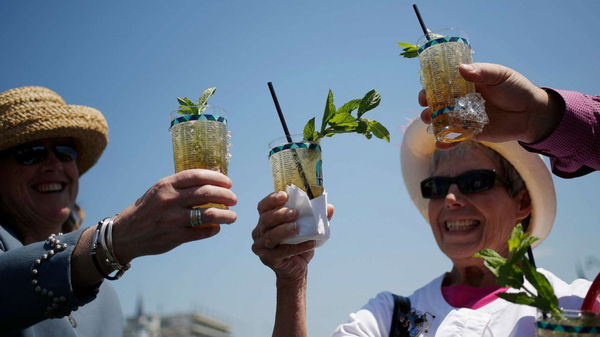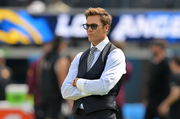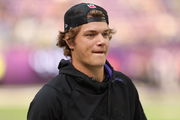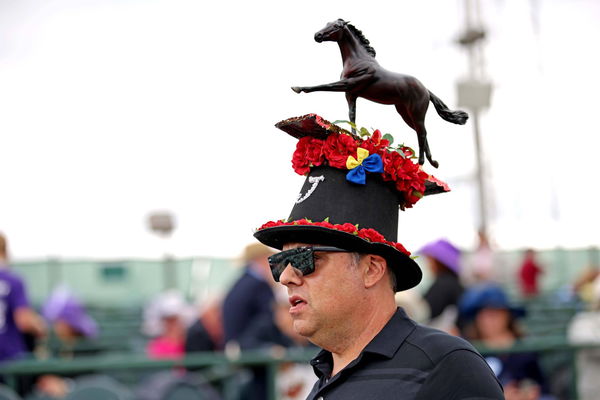
USA Today via Reuters
Horse Racing: 148th Kentucky Derby, May 7, 2022 Louisville, KY, USA A fans wears a festive hat celebrates winning the 148th running of the Kentucky Derby at Churchill Downs. Mandatory Credit: Jordan Prather-USA TODAY Sports, 07.05.2022 10:06:55, 18221573, NPStrans, Horse Racing, Kentucky Derby, Churchill Downs PUBLICATIONxINxGERxSUIxAUTxONLY Copyright: xJordanxPratherx 18221573

USA Today via Reuters
Horse Racing: 148th Kentucky Derby, May 7, 2022 Louisville, KY, USA A fans wears a festive hat celebrates winning the 148th running of the Kentucky Derby at Churchill Downs. Mandatory Credit: Jordan Prather-USA TODAY Sports, 07.05.2022 10:06:55, 18221573, NPStrans, Horse Racing, Kentucky Derby, Churchill Downs PUBLICATIONxINxGERxSUIxAUTxONLY Copyright: xJordanxPratherx 18221573
Attending the Kentucky Derby without a gorgeously crafted hat is a serious fashion faux pas. As many say, Derby Day is a time to ‘see and be seen.’ Derby fashion is an age-old tradition where women and even a few men sport one-of-a-kind Derby hats in this annual extravaganza. On the first Saturday in May, more than 150,000 people attend the event at Louisville’s Churchill Downs. So, what’s special this year, you ask? This year marks the 150th anniversary of America’s longest continuously held sporting event.
Watch What’s Trending Now!
Over the years, Kentucky Derby hats have become the most recognizable tradition of the “Run for the Roses.” As cheers fill the ground of 20 competing thoroughbreds putting up the “most exciting two minutes in sports,” the Kentucky Derby hat adds a lively flair to the action-packed atmosphere. Prior to this special edition, here’s all you need to know about the fashion mainstay’s cultural significance.
ADVERTISEMENT
What is the history behind Kentucky Derby hats?
During the English horse races in 1711, it was ordered that guests inside the Royal Enclosure adhere to a strict dress code, which included hats for ladies. The hats were a symbol of status at first, but the same highbrow group ultimately felt proud wearing a feather or several feathers in their hats. Meanwhile, since 1875, patrons of the famed Kentucky Derby paraded, flaunting their fashion whimsy.

ADVERTISEMENT
Derby hats have evolved over time. During the early years, most people wore modest headpieces or bonnets with netting, feathers, or other adornments. Later, in 1902, a tailor called Matt Winn took over the track, preserving the Derby’s fashion traditions. Winn positioned the Derby as a celebration of Civil War antebellum culture. Gibson Girl was the rage back then, exposing American ladies to larger, heavily decorated hats. Large hats embellished with flowers, feathers, ribbons, and pastel-colored clothes quickly became popular.
ADVERTISEMENT
Even men wore brightly colored traditional seersucker suits, dress shirts, and slacks in red, green, yellow, and orange tones. Hats were already beginning to fade due to fashion mandates, therefore it was up to the ladies to restore the race’s splendor. And they did an excellent job!
Top Stories
Cam Newton Makes NFL Return Conditions Clear to 32 Teams as Panthers Legend Confirms Retirement Stance

Tom Brady Makes Career Announcement for Vegas as Pete Carroll Addresses Losing Raiders Locker Room

Scottie Scheffler Makes Critical Health Announcement After He Ended PGA Tour Hiatus

J. J. McCarthy Awaits Punishment From Vikings After Rejecting Kevin O’Connell’s Instructions

Tiger Woods & Co. Now Have to Think Twice Before Trash-Talking at TGL Following New Update

Lexi Thompson Branded ‘Self-Centered’ After Retirement Decision Led to Chaos & Confusion

In other news, well-to-do Boston tea parties turned into activist network meetings to capitalize on their social standing to pass laws to safeguard bird species across the United States that were nearly vanishing unless they were on the tops of women’s hats. This eventually evolved into the Audubon Society, and regulations such as the Migratory Bird Treaty Act and others were enacted. There have been various variations of Derby fashion tales throughout the years, but the one that remains true is that these hat types vary depending on your seat at the venue.
ADVERTISEMENT
The seat you have dictates your hat style
In the Churchill Downs grandstand, if a woman sits right in front wearing a hat that blocks your vision, you will just have to roll with the punches and treat it like a norm. Unless others “outrank” her socially, in which case you could always accidentally spill your mint julep on her attire, forcing her to shift seats in more ways than one. However, in a different spot called the Infield, the hats are often wider. A while back, Jenny Pfanenstiel, a Louisville milliner noted, “people thought the bigger the hat, the bigger the luck.”

USA Today via Reuters
Horse Racing: 148th Kentucky Derby, May 7, 2022 Louisville, KY, USA A fan wears a festive hat before the 148th running of the Kentucky Derby at Churchill Downs. Mandatory Credit: Jordan Prather-USA TODAY Sports, 07.05.2022 12:27:11, 18222061, NPStrans, Horse Racing, Kentucky Derby, Churchill Downs PUBLICATIONxINxGERxSUIxAUTxONLY Copyright: xJordanxPratherx 18222061
There are no strict rules for hats on the racetrack. However, there is an unwritten law to wear something on your head; otherwise, you would stick out like a sore thumb. So, what are you waiting for? Come grab your on-fleek hats today.
ADVERTISEMENT
ADVERTISEMENT
ADVERTISEMENT
ADVERTISEMENT

